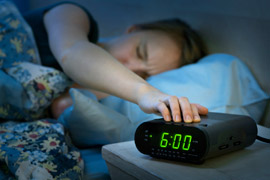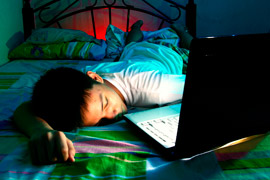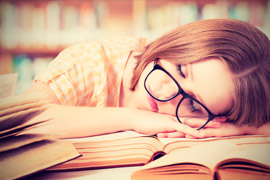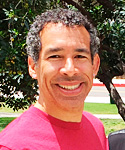July 27th, 2016
School Schedules Make for Sleepy Teens
Scott Cuyjet, RN, MSN, FNP-C

As a parent of teenagers, I am reminded of that statistic every night as I try to get them to sleep at a reasonable hour, and every morning, as much as I struggle to get up, it is much worse for my 15- and 16-year-olds. Every day I have to cajole and sometimes force them to get up and get ready. They slowly move through their morning routine like zombies as I remind them of things they need to do to get ready.
These research findings are also relevant to my job as a nurse practitioner, as most of my patients are high-school-age. This is one of the reasons our clinic opted to open at 9:30 a.m. at its inception 25 years ago. At that time, our founders were aware of the data supporting the importance of sleep for adolescents. Some of the documented health deficits associated with lack of sleep include being overweight, alcohol and substance use, smoking, and poor academic performance.
Today, there are many barriers to adolescents getting enough sleep. One of them is the use of electronic devices like cell phones, tablets, eReaders, and laptops, which are often used right before going to sleep. In a 2014 paper, sleep researchers documented disrupted Circadian rhythms in people using light-emitting e-readers before bedtime and noted the particular challenges for children and adolescents, “who already experience significant sleep loss.” The authors called for further epidemiological research evaluating the long-term health and safety consequences of e-readers. (My mom, a librarian, would argue that this is a reason to go back to paper books, at least before bed.)
Another source of sleep deprivation, according to my adolescent patients, is the amount of homework they have on top of other activities. In one recent article, students report spending a nightly average of over three hours on homework. Many students don’t even get to start homework until later in the evening given their after-school activities.  A recommendation by one national homework expert cited in that article is: “multiplying the student’s grade level by 10 to get the optimal amount of time that should be spent on homework each night; this means that freshmen in high school should spend no more than 90 minutes and seniors no more than 120 minutes on homework each school night.” Granted, this recommendation can only be implemented with buy-in and participation from teachers.
A recommendation by one national homework expert cited in that article is: “multiplying the student’s grade level by 10 to get the optimal amount of time that should be spent on homework each night; this means that freshmen in high school should spend no more than 90 minutes and seniors no more than 120 minutes on homework each school night.” Granted, this recommendation can only be implemented with buy-in and participation from teachers.
In response to this issue, the American Academy of Pediatrics recommends that middle and high schools should start at 8:30 a.m. or later to allow students the opportunity to get the recommended amount of sleep on school nights (about 8.5–9.5 hours). In my own experience, I would say that 9:00 or 9:30 a.m. would be even better start times, although I recognize that getting kids to school at that time might be difficult for parents whose work day starts before then.



An excellent selection of SOME of the sleep ECOLOGY factors for adolescents – all known and research validated over several decades. . . .
Also one might add the known depressive effects of Social Network access (i.e. the more Facebook – the more depression), the underestimated incidence of adolescent depression (and depression/mood effects on sleep ecology). The commonest sleep lab diagnosis of adolescents is “phase shift disorder” – it’s as if they are in the wrong time zone – by a few hours. Maybe Scot’s kids don’t indulge, but 50% (more or less) of adolescents are also using sleep active chemicals (legit – the stimulants for example and illegit – THC “to sleep”, alcohol etc.). Fatigue is a circular issue – as is dehydration (first major signs are impaired short term memory and cognition – NOT thirst!), not to mention those who show up at school without having eaten a breakfast.
But I think you are hinting at changes systems need to or could make to improve the situation – more suggestions?
Max,
Thank you for reading the blog and for your thoughtful response. I am limited to how long the blog can be and appreciate the additional points you have added.
Scott